I never appreciated Ensaladang Pako until I started cooking it myself in my own kitchen. What began as just another leafy side dish from my Lola's Sunday lunch table has become one of my favorite ways to eat healthy without feeling like I'm on a diet. This simple Filipino salad combines tender fiddlehead ferns with juicy tomatoes and salted eggs, all brought together by a light, tangy dressing that makes every bite refreshing and satisfying.
The best thing about this recipe? It's virtually impossible to mess up! Even as a beginner cook, I managed to make it taste great on my first try. Now I make it at least twice a month, especially when I want something fresh to go with grilled fish or any ulam.
It only takes 20 minutes to prepare, uses ingredients you can find in any local market, and always gets compliments from guests. This Ensaladang Pako recipe is definitely worth trying.
Jump to:
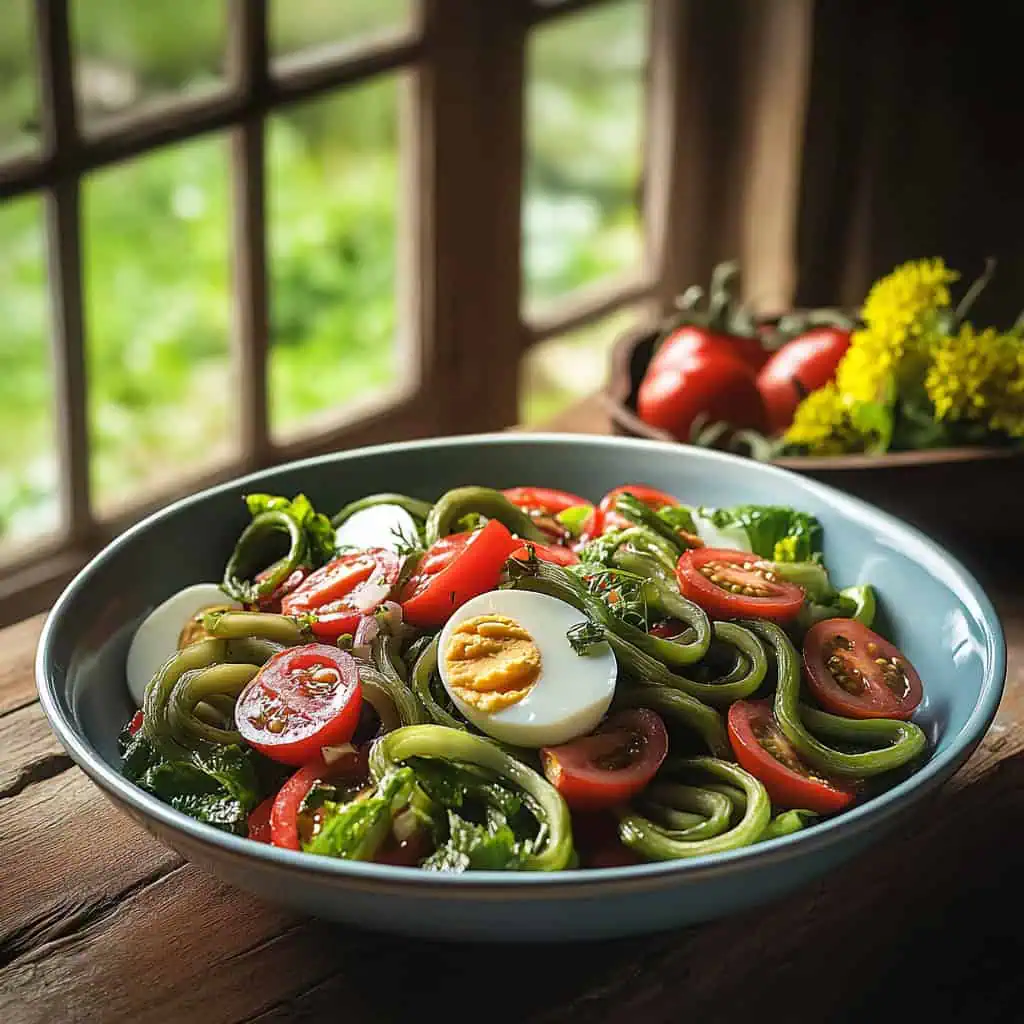
Why You'll Love This Recipe
- Light and Refreshing: Perfect for hot weather
- Health-Conscious: Low in calories and high in nutrients
- Quick and Easy: Ready in just 20 minutes
- Versatile: Can be customized with various ingredients
- Authentic: A true taste of Filipino cuisine
- Weight-Management Friendly: High in fiber, keeping you fuller longer
Ingredients
Each ingredient in Ensaladang Pako serves a specific purpose, creating a perfect balance of flavors and textures. The star ingredient, fiddlehead ferns, provides a unique earthy taste and delightful crispness that can't be replicated by other greens.
Juicy tomatoes add freshness and natural sweetness, while salted eggs contribute a rich, savory dimension that complements the light ferns. The sharp bite of white onions adds complexity, and calamansi juice brightens everything with its distinctive citrus tang.
Finally, fish sauce anchors the dish with umami depth, while the simple olive oil and vinegar dressing enhances rather than overpowers these carefully selected ingredients.

For the Salad:
- 2 cups pako leaves (fiddlehead fern)
- 2 tomatoes, sliced into wedges
- 2 salted eggs, sliced into quarters
- 1 white onion, thinly sliced into rings
- 2 pieces calamansi, juiced
- Fish sauce (patis) to taste
For the Dressing:
- 3 tablespoons olive oil
- 1 tablespoon apple cider vinegar
- Freshly ground black pepper to taste
Equipment
- Large pot (kaldero) - For blanching the ferns to achieve the perfect tender-crisp texture
- Colander (salaan) - Essential for draining the blanched ferns properly
- Sharp knife (kutsilyo) - For precise cutting of tomatoes, onions, and salted eggs
- Cutting board (sangkalan) - Provides a stable surface for ingredient preparation
- Large mixing bowl (mangkok) - Allows enough space to gently combine all ingredients without bruising
- Tongs or salad servers - Helps toss the delicate ingredients without damaging the ferns
- Small bowl - For mixing the dressing ingredients thoroughly

How To Make
- Bring a large pot of water to a boil. Once boiling, turn off the heat (water temperature should be around 180°F). Place the cleaned pako in the hot water and let them cook for 3-5 minutes until slightly tender but still crisp.
- Drain the ferns in a colander, then immediately squeeze calamansi juice over them to prevent darkening. Set aside to cool while preparing other ingredients.
- Slice the tomatoes into wedges, thinly slice the white onion into rings, and cut the salted eggs into quarters.
- In a small bowl, make the dressing by combining olive oil, apple cider vinegar, and freshly ground black pepper. Mix well until blended.
- Arrange the blanched pako in a large serving bowl. Layer the sliced tomatoes, white onions, and salted eggs on top. Drizzle with the prepared dressing and add fish sauce to taste.
- Gently toss all ingredients together until well combined. Taste and adjust seasonings as needed by adding more fish sauce or calamansi juice. Serve immediately while fresh and crisp.

Tips from Lola's Kitchen
- Select the right ferns: Look for young, bright green ferns with tightly coiled fronds. These offer the best texture and flavor with no bitterness.
- Blanching technique: The quick-blanch method is crucial - ferns should remain slightly crisp after cooking. Overcooking results in mushy, dark ferns.
- Color preservation: Adding calamansi juice immediately after blanching helps maintain the vibrant green color.
- Layering flavors: Build the salad in layers rather than mixing everything at once to distribute flavors evenly.
- Chill before serving: For an extra refreshing experience in hot weather, chill all ingredients (except the blanched ferns) before assembly.
- Fish sauce adjustment: Start with less fish sauce than you think you need - you can always add more to taste.
- Texture balance: The contrasting textures (crisp ferns, juicy tomatoes, firm eggs) make this salad special - handle ingredients gently to preserve these textures.
Substitutions
- Can't find calamansi? Use a mixture of lime and mandarin orange juice (2:1 ratio) for a similar flavor profile.
- No salted eggs available? Use regular hard-boiled eggs sprinkled with a little sea salt.
- Apple cider vinegar alternatives: Rice vinegar, white wine vinegar, or even a splash of coconut vinegar will work wonderfully.
- Olive oil substitutes: Any light-tasting oil such as avocado oil or grapeseed oil makes a good alternative.
- White onion replacement: Red onions or shallots offer a milder, slightly sweeter flavor if white onions are too strong.
- Vegetarian version: Replace fish sauce with light soy sauce or coconut aminos.
Troubleshooting
- Bitter-tasting ferns: This usually indicates older ferns were used. Next time, look for younger, more tightly coiled fronds. For immediate fix, add a pinch of sugar to the dressing.
- Darkened ferns: If your ferns turn dark despite blanching, apply more calamansi juice and add a small pinch of sugar to brighten the flavor.
- Too salty dish: Balance excessive saltiness with additional acid (more calamansi juice) or add more unseasoned vegetables like cucumber.
- Watery salad: Ensure ferns are thoroughly drained and patted dry before assembling. If already assembled, gently transfer to a new bowl, leaving excess liquid behind.
- Wilted appearance: This salad is best served fresh. If ingredients have wilted, revive with a quick ice bath before reassembling.
Storage & Reheating
- Optimal freshness: Ensaladang Pako is best consumed immediately after preparation for optimal texture and flavor.
- Short-term storage: If necessary, store components separately in airtight containers for up to 24 hours in the refrigerator. Keep dressing separate from vegetables.
- Assembly after storage: Bring refrigerated components to room temperature before combining to enhance flavors.
- Not recommended: Freezing this salad is not recommended as it will significantly damage the texture of the delicate ferns.
- Quick refresh: If stored salad becomes slightly wilted, a light sprinkling of fresh calamansi juice can help revive some brightness.
Traditional Serving Suggestions
- Classic pairings: Ensaladang Pako traditionally accompanies grilled fish (inihaw na isda), especially milkfish (bangus) or tilapia.
- Complete meal concept: Serve alongside Filipino BBQ skewers and steamed rice for a balanced meal representing Filipino cuisine's best flavors.
- Kamayan style: Include as part of a kamayan feast, where it provides a refreshing contrast to richer, meat-based dishes.
- Modern approach: Use as a bed for grilled seafood in contemporary plating for an elevated presentation.
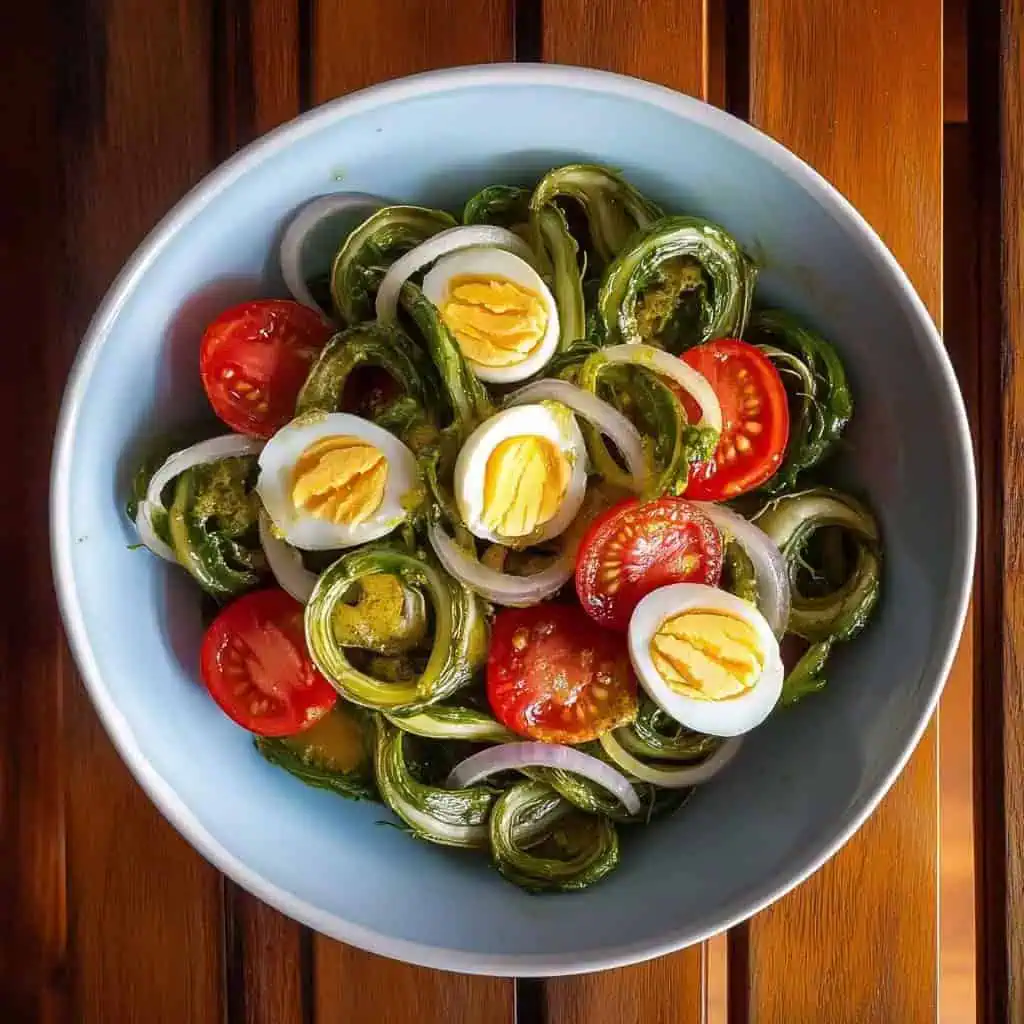
FAQ
Where can I find pako/fiddlehead ferns?
Look in Asian markets, farmers' markets, or specialty produce stores. They're most abundant during spring and early summer. In some areas, Filipino or Southeast Asian grocery stores regularly stock them fresh or frozen.
How do I clean fiddlehead ferns properly?
Rinse thoroughly under cold running water, removing any brown papery coverings. For wild-harvested ferns, soak briefly in cold water with a splash of vinegar to remove any debris.
Can I eat pako raw?
While some eat it raw, blanching is recommended for food safety, improved digestion, and better flavor. Raw ferns can sometimes taste slightly bitter and contain compounds that may cause digestive discomfort in some people.
How do I know if pako is fresh?
Look for bright green, tightly coiled fronds with no signs of browning, yellowing, or sliminess. Fresh ferns should feel crisp and spring back when gently bent.
Is this recipe suitable for special diets?
This recipe is naturally gluten-free, low-carb, and can be adapted for vegetarian diets by substituting fish sauce with soy sauce or coconut aminos. It's keto-friendly and rich in vitamins and minerals.
Can I make this ahead for a party?
Prepare components separately and assemble just before serving for the best results. The blanched ferns can be prepared up to 12 hours ahead if properly stored in the refrigerator with a squeeze of calamansi juice.
What are the nutritional benefits of fiddlehead ferns?
Fiddlehead ferns are rich in antioxidants, omega-3 fatty acids, iron, and fiber. They also contain vitamins A and C, contributing to their status as a nutritional powerhouse.
How can I make this salad more filling?
Add protein sources like grilled chicken, shrimp, or tofu. You can also incorporate more substantial vegetables like roasted sweet potatoes or add quinoa for a modern fusion approach.
Related
Looking for other recipes like this? Try these:

Ensaladang Pako (Filipino Fiddlehead Fern Salad) Recipe
Equipment
- Large pot (kaldero) for blanching the ferns
- Colander (salaan) for draining the blanched ferns
- Sharp knife (kutsilyo) for slicing ingredients
- Cutting board (Sangkalan) for preparation
- Large mixing bowl (mangkok) for combining ingredients
- Tongs or salad servers for tossing
- Small bowl for mixing dressing
Ingredients
For the Salad
- 2 cups pako leaves Fiddlehead Fern/Pakong-gubat
- 2 tomatoes kamatis, sliced
- 2 salted eggs itlog na maalat, sliced
- 1 white onion sibuyas, thinly sliced
- 2 pieces calamansi kalamansi, juiced
- Fish sauce patis to taste
For the Dressing
- 3 tablespoons olive oil
- 1 tablespoon apple cider vinegar or any vinegar
- Pepper powder to taste
Instructions
- Bring a large pot of water to a boil. Once boiling, turn off the heat. The water temperature should be around 180°F. Place the cleaned pako (fiddlehead ferns) in the hot water and let them cook for 3-5 minutes until slightly tender but still crisp.
- Drain the ferns in a colander, then immediately squeeze calamansi juice over them to prevent darkening. Set aside to cool while you prepare the other ingredients.
- Slice the tomatoes into wedges, thinly slice the white onion into rings, and cut the salted eggs into quarters.
- In a small bowl, make the dressing by combining olive oil, apple cider vinegar, and pepper powder. Mix well until blended.
- Arrange the blanched pako in a large serving bowl. Layer the sliced tomatoes, white onions, and salted eggs on top. Drizzle with the prepared dressing and add fish sauce to taste.
- Gently toss all ingredients together until well combined. Taste and adjust seasonings if needed by adding more fish sauce or calamansi juice. Serve immediately while fresh and crisp.
- Remember to handle the ferns gently when tossing to maintain their delicate shape. The salad tastes best when served right away, while the pako is still bright green and all ingredients are fresh.
Tips from Lola's Kitchen
- Choose young, bright green ferns for the best texture and flavor
- Don't overcook the ferns - they should remain slightly crisp
- Add calamansi juice immediately after blanching to maintain the bright green color
- Adjust fish sauce gradually - you can always add more, but you can't take it away
- Serve immediately for the best texture and freshness
Nutrition
The Story Behind Ensaladang Pako
Long before farm-to-table became trendy, Filipino families were gathering pako (fiddlehead ferns) from local forests and backyard gardens to create this refreshing salad. In the Philippine countryside, these young fern fronds grow abundantly during the rainy season, making them a cherished ingredient in traditional Filipino cuisine. What started as a practical way to use these readily available greens has evolved into a beloved dish that perfectly represents the Filipino talent for transforming simple ingredients into something special.
Ensaladang Pako tells the story of Filipino resourcefulness and our deep connection to local ingredients. In many provinces, especially in regions like Bicol, Quezon, and various parts of Mindanao, gathering pako is still a common practice. Local vendors at traditional markets often sell freshly gathered ferns alongside other forest vegetables, maintaining this age-old tradition of bringing nature's bounty to Filipino tables.
The genius of this dish lies in its simplicity. The traditional preparation method of blanching the ferns wasn't just about taste – it was our ancestors' way of making the ferns more digestible while preserving their nutrients. The addition of salted eggs (itlog na maalat) reflects the Filipino mastery of food preservation, while calamansi adds that distinctly Filipino citrus touch that we've come to love in our local cuisine.
Today, Ensaladang Pako has found its way from humble provincial tables to trendy Filipino restaurants in cities like Manila, Cebu, and even abroad. Its rising popularity coincides with the global movement toward healthier, plant-based eating. Health-conscious food lovers appreciate not just its unique taste and texture, but also its impressive nutritional profile – packed with vitamins A and C, iron, and fiber.
What makes this salad truly special is how it connects modern Filipino dining with our cultural heritage. Whether served in a banana leaf at a local carinderia or plated elegantly in a high-end restaurant, Ensaladang Pako remains a testament to the Filipino skill of creating extraordinary flavors from ordinary ingredients. It's more than just a salad – it's a fresh, green taste of our culinary history that continues to delight new generations of food lovers.






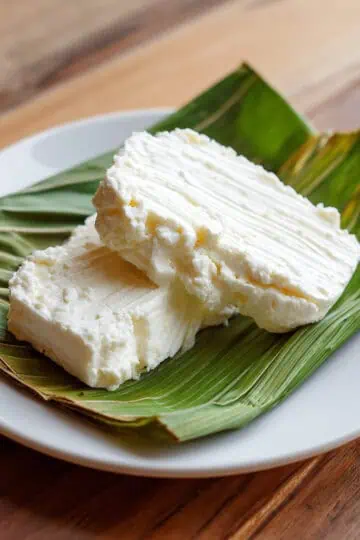
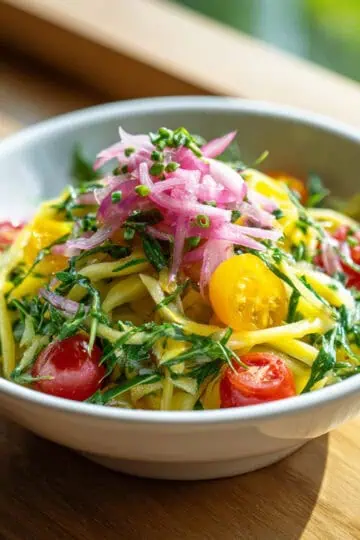
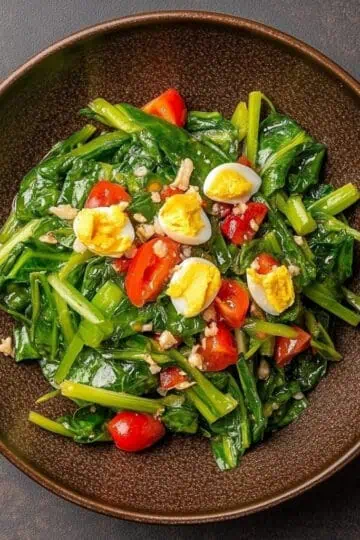

Comments
No Comments